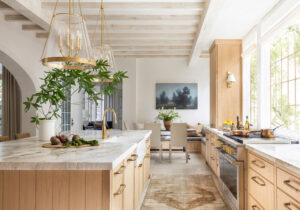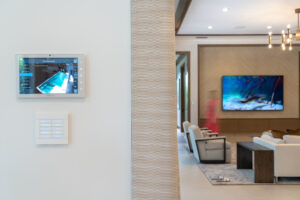

According to the National Association of REALTORS®1, a smart home allows homeowners to control appliances, thermostats, lights, and other devices remotely using a smartphone or tablet through an internet connection.
While this is the standard definition of a smart home, it doesn’t define what is necessary to truly build and design the smart home of today, in which the design/build industry has continued to place a larger emphasis on creating spaces that are “designer ready” instead of being “toothbrush ready.”
The “toothbrush-ready” home definitely isn’t a new concept in home development, but it means that the home should be completely ready for move in with all the smart technology inside working properly, where all the new homeowner has to do is bring their toothbrush and settle in.
Although the aesthetic appeal of the home is still important for today’s aspiring home buyer, it’s time for a paradigm shift in the design/build industry for the modern age of smart living and functional needs. We must move away from the sole pursuit of visual appeal toward the more holistic “toothbrush ready” approach that prioritizes livability and functionality at the onset of planning and construction.
Prioritizing Functionality in Home Design
Traditionally speaking, home design has been focused between form and function, with aesthetics and structural infrastructure taking center stage.
An open floor plan, enough closet space, plenty of lighting, modern appliances, and rooms enough for families are some of the everyday living necessities the average homebuyer continues to prioritize. However, comprehensive smart home automation is now one of the top demands architects and builders are tasked with, especially in affluent communities2.

This shift toward prioritizing sophisticated home automation and functionality alongside aesthetics is not merely a suggestion; it’s a necessity born out of the changing needs and lifestyles of homeowners. Gone are the days when a home was merely a showcase for guests, and everything had to be manually controlled. Today, the home is the sanctuary where we live, work, and play, and the automation of lighting, climate, security, and even window treatment control needs to be seamlessly integrated for the ultimate experience.
Integrating Infrastructure: A Holistic Approach to Design
One of the key pillars of toothbrush-ready design is infrastructure. Beyond the common aspects of design, such as paint colors and furniture selection, architects and builders must anticipate the fundamental infrastructure requirements of a home.
With smart home technology becoming increasingly ubiquitous, integrating these systems seamlessly into the fabric of the home is essential. This includes ensuring adequate wiring for networking, speakers, security systems, motorized window treatments, lighting control and home automation devices.
Additionally, careful consideration must be given to the architectural design of the home to accommodate all types of window treatments to allow them to seamlessly blend into the aesthetic of the home. By addressing these infrastructure needs proactively during the design phase, architects and builders can future-proof homes and ensure they are well-equipped to meet the demands of modern living.
Investing in Livability: The Appeal of Toothbrush-Ready Homes
As smart home technology features are a major step in developing the “toothbrush ready” home, the most crucial aspect of this design is the shift in mindset it requires from the design and construction community.
No longer can architects simply hand off their plans to a builder or general contractor and remove themselves from the practical considerations of the home. Instead, they must work closely with all stakeholders, including homeowners, builders, interior designers, and custom technology integrators to ensure that every aspect of the design contributes to the overall livability of the space.
And choosing the right custom integrator is an essential step. That’s why today Architects are increasingly focused on partnering with larger, nationally recognized custom integrators who provide strong financial stability, a holistic network of national automation vendors, and 24/7 customer support available across a variety of home development projects. Homeowners are no longer satisfied with spaces that look good on paper but fail to meet their practical needs. Instead, they are seeking homes that not only reflect their personal style but also support their day-to-day activities and routines as easy as the push of a button.

The design/build industry needs to embrace the proactivity of working side-by-side with architects and integrators to establish the toothbrush-ready home completely. By prioritizing smart home automation and livability alongside aesthetics, architects and builders can create spaces that not only dazzle the eye but also enrich the lives of those who inhabit them. It’s a shift that demands a new approach, a new mindset, and a renewed commitment to meeting the evolving needs of homeowners in our modern world.
About the Author: Jeff Halloran is the Vice President of Operations for BRAVAS, a national custom integrator of smart home and automation solutions for luxury residences across the U.S. For more information, please visit www.bravas.com.